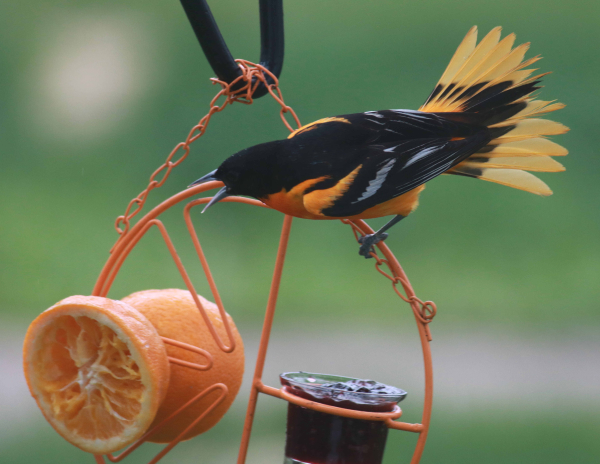
At first, Paul was disappointed when an aggressive Baltimore Oriole took over his smaller oriole feeder, but he quickly recognized this would be a short-lived opportunity to photograph some of the resulting interactions between the colorful orioles.
|
For a couple weeks each spring, Baltimore Orioles make a stopover in my neighborhood and dominate the feeding station outside my bay windows, providing a level of excitement for me that’s tough to beat. Invariably, more orioles assemble than feeding perches, or one male becomes dominating, spending more energy chasing and fighting fellow orioles than actually feeding. Not all orioles opt to react to the bully passively, which makes for some fun orange action at the oriole feeders.
When the big numbers of orioles arrive, which may include a dozen at a time, I set up a second platform to add four orange halves and a bowl full o’ grape jelly. But my regular oriole feeder hangs from my feeding station with a smallish jelly container and a pair of spikes to hold orange halves, and that’s where most of the oriole aggression takes place. And it sure makes for some fun and colorful photo action, which I capitalized on through my big bay windows.
Yes, I did say through the windows. It’s definitely not ideal to photograph through a window, especially considering how much emphasis we place on lens quality and sharpness of photo images. But unless you make another option, like a backyard photo studio, you work with what you have – especially when a photo opportunity is created literally before your eyes. When in doubt, it’s worth a try; or opt for a better plan if that’s possibe.
A Little Blur Shows Action

Rarely did the small feeder hold three orioles at the same time, and when it did, spirited competition would ensue.
|
The other thing working against my interests in photographing fast-action oriole fights were the overcast conditions, sometimes turning to sprinkles of rain. It would take a very fast shutter speed to do justice to the oriole interactions, but upping the ISO setting to 800 gave me adequate shutter speeds to stop most of the action. Even so, there was some blur in the wings in some images, but ultimately, that shows action, which can be something of a plus in some of the accompanying examples.
As always, the shutter speed and aperture are a balancing act, and by choosing a narrower depth of field with the f6.3 aperture setting, I would get a faster shutter speed. As usual I used the Av setting on my camera dial, so by setting the aperture to f6.3, I usually had 1/500 second shutter speed or faster to work with. I figured I could use a smaller depth of field because the orioles should all be positioned on the same narrow plain of my feeder. Also, the narrower depth of field provided a fairly out of focus background, which served to accent the birds better.
Beyond the technical aspects, trying to photograph the interactions at my oriole feeder was fun and exciting. Most of all, try to anticipate action and interactions, and keep on subject if the birds continue to fight beyond an initial jab or two.
A Brawl Breaks Out

This particular oriole feeder invites acrobatic movements among orioles that sometimes hang upside down when feeding, and it allowed quick and sometimes dramatic reactions to the thrust of a sharp beak.
|
At one point, a first year male Orchard Oriole, olive-colored compared to the chestnut-colored adult male, began asserting its dominance at the feeder, which I knew was a precursor to a showdown. Sure enough, it happened, and I was there to document it. It was no small battle; it continued across my front yard and onto the ground, where I thought the adult would murder the yearling.
The point was made in a serious way, and when the adult finally let up, the yearling remained groggy for some moments, and it smartly relinquished the throne to the adult thereafter. The intense fight took place a distance away and did not lend itself to getting even one photo worthy of sharing here, but that’s a big part of action photography – a small percentage work out. But when they do work, they are memorable.

With a varied level of blurring photo to photo that reveals the fast action, the shutter speed was usually adequate under the cloudy conditions.
|
Orioles are usually passive beautiful birds that we welcome to our yards and feeders, but sometimes, during a relatively short migration stopover when many orioles assemble at a valuable food source, some aggressive behavior is likely to break out. If it does, make the most of it; enjoy the action, and enjoy the fruits of your feeding station and your photographs. Orioles are headed north now, so be ready with a well-stocked section of your feeding station with sliced oranges and the best oriole magnet – grape jelly. Enjoy the action!
Article and photos by Paul Konrad
Share your bird photographs and birding experiences at editorstbw2@gmail.com